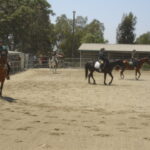 Just the other day I asked a student to do the “usual” warm up. Now I didn’t think this to be a difficult task since I had instructed her through this same warm-up at the beginning of every lesson for nearly a year. However, since I had always told her what to do, she never understood that she was doing a warm up. This was my mistake. Therefore; a long conversation ensued about what the purpose of a warm up is, how it helped both the horse and rider and what you should do to ensure that everyone was ready for the task at hand. But it got me thinking. How many riders know how to do a good warm up? Do they even do one at all? Based on what I see in the “warm up” pen at shows, one could wonder.
Just the other day I asked a student to do the “usual” warm up. Now I didn’t think this to be a difficult task since I had instructed her through this same warm-up at the beginning of every lesson for nearly a year. However, since I had always told her what to do, she never understood that she was doing a warm up. This was my mistake. Therefore; a long conversation ensued about what the purpose of a warm up is, how it helped both the horse and rider and what you should do to ensure that everyone was ready for the task at hand. But it got me thinking. How many riders know how to do a good warm up? Do they even do one at all? Based on what I see in the “warm up” pen at shows, one could wonder.
A good warm up will help prepare both the horse and rider for the work ahead. How much you include in your warm up will depend on your riding level and your horses training level. If you are a beginner, some simple stretches on the ground or in the saddle will suffice for the rider. Often just riding at a walk and trot is exercise enough for those who only ride once a week. I usually have my riders spend some time in “balance position” or “two-point position” during each ride. These positions help stretch muscles, increase strength and improve balance.
My beginner school horses actually seldom get a complete warm up, since their riders aren’t capable of more than walk and a bit of trot. I believe everyone should do at least one circle at each gait and each direction. Frequent changes of direction will work both sides of horses and riders while keeping the lesson more interesting. Therefore; my level 2 riders (walk/trot beginning canter) warm up routine is- Ride one complete circuit of the arena at a walk each direction. One small, walking circle each direction. Ride one complete circuit of the arena at a sitting trot/jog each direction with a small circle. Finally, they will also do the same at posting trot. Once that is completed, the group will be brought together for the lesson to begin.
If you and your horse are more advanced (Level 3 and up), some canter and/or lope will be in order. At least 2 times around the arena with a circle in each direction should be included. I always start in a faster canter before asking my horses to slow down, collect and lope. Reverses usually involve dropping out of the canter for the change of direction. Once the horse has worked on both leads, flying lead changes can be put in the warm up if the horse and rider are proficient in them. For advanced horses and riders, bending, leg yields, haunches in/out and shoulder in/out may also be part of the warm up routine.
Whatever your routine is, be sure it uses your horses strengths to the best advantage. Only do what your horse can do well during the warm up. Wait until everyone is completely ready for new tasks before undertaking them. This is not the time to learn or practice a new skill. Save the weaker areas of your horses training for the actual work portion of the ride. If you are still struggling with a simple lead change, don’t include it in the warm up. Bring the horse back to a walk or trot, complete the reverse, then pick up the new lead after the direction has been changed.
After you have completed your work for the day, be sure you cool your horse out before you put him away! How do you know if your horse is cooled out and ready to quit for the day? That is a conversation for another day…
